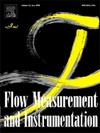一种基于电导率的传感器,用于测量结构化填料柱中的液膜厚度和表面润湿性
IF 2.3
3区 工程技术
Q2 ENGINEERING, MECHANICAL
引用次数: 0
摘要
本文介绍了一种用于研究润湿性能的传感器,即结构化填料柱中的非润湿、部分润湿和完全润湿通道,以及它们在填料片上相应的薄膜厚度。采用数值方法优化传感器电极的形状,以获得足够的动态范围来测量薄膜厚度和高空间分辨率。为此,使用COMSOL Multiphysics®模拟不同厚度液膜中的势场分布。该传感器被制成薄而灵活的印刷电路板(PCB)带,使其易于粘合到包装片的表面。在单条实验装置中,通过在传感器上形成具有定义厚度的静态液体膜来进行性能测量,然后通过这些测量获得的数据用于校准传感器并验证数值模型。该传感器根据液相的电导率检测湿区和非湿区,可以测量厚度达1.7 mm的液膜。随后,将其粘合到Mellapak 250Y®的波纹片上,以研究填充柱中的润湿性能并测量局部膜厚度。研究了垂直柱和倾斜柱的液流分布和平均膜厚,并比较了倾斜对润湿性能的影响。本文章由计算机程序翻译,如有差异,请以英文原文为准。
A conductivity-based sensor for the measurement of liquid film thickness and surface wetting in structured packing columns
This work introduces a sensor designed to study the wetting performance, i.e. non-wetted, partially wetted, and fully wetted channels, in a structured packing column along with their corresponding film thicknesses on the packing sheets. A numerical approach was followed to optimize the shape of the sensor electrodes in order to achieve both sufficient dynamic range for film thickness measurements and high spatial resolution. For this purpose, COMSOL Multiphysics® was used to simulate the potential field distribution in liquid films of different thicknesses. The sensor was fabricated as a thin and flexible printed circuit board (PCB) strip, making it easy to bond it to the surface of the packing sheets. Performance measurements were conducted by forming static liquid films with defined thicknesses on a sensor in a single-strip experimental setup, and the data obtained from these measurements were then used to calibrate the sensor and to validate the numerical model. The sensor detects wetted and non-wetted areas based on the electrical conductivity of the liquid phase and can measure liquid films with thicknesses of up to 1.7 mm. Subsequently, it was bonded to the corrugated sheets of Mellapak 250Y® to study the wetting performance in a packed column and to measure local film thicknesses. The liquid flow distribution and average film thickness were investigated for both an upright vertical column and a tilted column, and then compared to determine the impact of inclination on wetting performance.
求助全文
通过发布文献求助,成功后即可免费获取论文全文。
去求助
来源期刊

Flow Measurement and Instrumentation
工程技术-工程:机械
CiteScore
4.30
自引率
13.60%
发文量
123
审稿时长
6 months
期刊介绍:
Flow Measurement and Instrumentation is dedicated to disseminating the latest research results on all aspects of flow measurement, in both closed conduits and open channels. The design of flow measurement systems involves a wide variety of multidisciplinary activities including modelling the flow sensor, the fluid flow and the sensor/fluid interactions through the use of computation techniques; the development of advanced transducer systems and their associated signal processing and the laboratory and field assessment of the overall system under ideal and disturbed conditions.
FMI is the essential forum for critical information exchange, and contributions are particularly encouraged in the following areas of interest:
Modelling: the application of mathematical and computational modelling to the interaction of fluid dynamics with flowmeters, including flowmeter behaviour, improved flowmeter design and installation problems. Application of CAD/CAE techniques to flowmeter modelling are eligible.
Design and development: the detailed design of the flowmeter head and/or signal processing aspects of novel flowmeters. Emphasis is given to papers identifying new sensor configurations, multisensor flow measurement systems, non-intrusive flow metering techniques and the application of microelectronic techniques in smart or intelligent systems.
Calibration techniques: including descriptions of new or existing calibration facilities and techniques, calibration data from different flowmeter types, and calibration intercomparison data from different laboratories.
Installation effect data: dealing with the effects of non-ideal flow conditions on flowmeters. Papers combining a theoretical understanding of flowmeter behaviour with experimental work are particularly welcome.
 求助内容:
求助内容: 应助结果提醒方式:
应助结果提醒方式:


